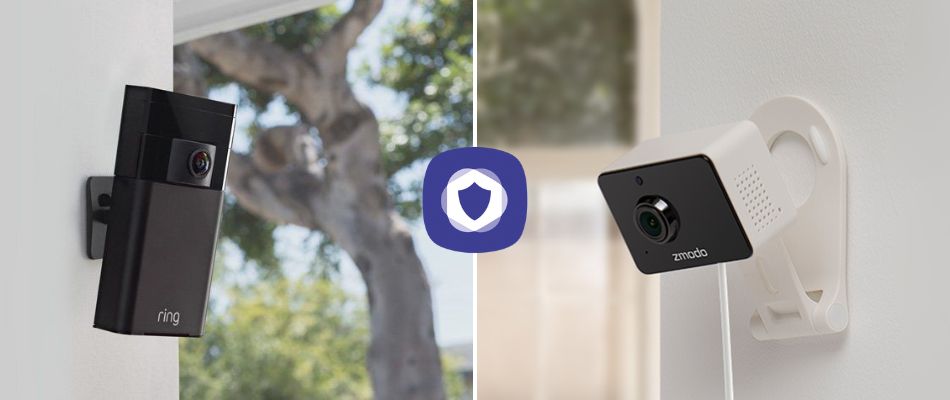Whether upgrading your home security or you‘re a novice in the world of security cameras, it can be hard to make the right choice. You’ll have dozens of options to choose from, and two great options are Ring and Zmodo cameras.
Ring is a pretty new home security company with around ten years in the industry. They shot to fame in 2013 with the Ring video doorbell. Zmodo is a global provider of security camera systems, with several similarities and some differences. Let’s see what they can offer you.
Ring vs Zmodo: What do they have in common?
- Installation: Ring and Zmodo are DIY installations only; if you require professional installation, you’ll need to find an independent tradesperson.
- Voice control: With the help of Amazon Alexa, you can control your system with voice control.
- Motion alerts: You can receive notifications when your motion sensors are triggered, which is helpful as you won’t be watching your live feed 24/7.
- Flexibility: There are no cancellation fees, activation fees, or long-term contracts involved with Ring or Zmodo.
- Weatherproof cameras: Ring and Zmodo offer a selection of outdoor cameras that won’t be damaged by typical outdoor weather.
- Mobile app: You can download an iOS or Android mobile app for both home security systems.
- Night vision: Each provider offers infrared night vision compatibility.
Ring vs Zmodo: What are the differences?
- Video quality: Most Ring cameras have 1080p HD video quality, but Zmodo cameras stop at 720p HD.
- Pricing: Zmodo’s cameras start at $29. Ring’s smart doorbells start at $99.
- Professional monitoring: Ring can monitor your system for just $10 a month, but Zmodo doesn’t offer professional monitoring.
- Alerts: The motion detection alerts offered by each home security camera differ; Ring offers instant alerts while Zmodo will send you a 30-second clip.
- Pre-recorded messages: Zmodo Greet can welcome your guests with a pre-recorded message if you’re unable to get to the door in time.
- Cloud storage: Zmodo offers free cloud storage, but Ring will require a subscription.
Ring: What you need to know
Ring was launched in 2013, first coming to prominence with its video doorbell. They’ve expanded further since then and offer extras such as environmental sensors and compatibility with smoke alarms.
Installation
Wired installations can be complex due to the extra hardwiring required, but the Wi-Fi cameras are pretty simple to install. Amazon can provide some assistance depending on where you live, or you can contact your own local tradesperson, but professional installation isn‘t typically offered.
Equipment
Ring offers a variety of equipment, including:
- Smart locks
- Motion detectors
- Video doorbells
- Indoor and outdoor cameras
- Panic buttons
- Lighting
The base package includes:
- Base station
- Keypad
- Five contact sensors
- Two motion detectors
- Range extender
Home automation
Ring doesn’t offer many third-party integrations, but it can be integrated into a decent smart home ecosystem featuring window/door sensors, smart lights, smoke detectors, and more. The Ring app also offers several key features to keep your home safe and connected.
Pricing
- Equipment costs: The basic Ring security system costs less than $200, and individual cameras (doorbell cameras) are available for $99.
- Monthly costs: Professional monitoring is available for $100 per year or $10 monthly.
Nerd pros
- Cameras: Ring provides various camera options, including indoor and outdoor cameras with night vision and other great features.
- Professional monitoring option: If you want professional monitoring, you can purchase it for $10 per month.
- Two-way audio: Two-way talk is a convenient feature that makes it seem that you're home - even if you're not. You can communicate with a friend or instruct a delivery person on where to leave your parcel.
Nerd cons
- Monthly fees: Ring charges a higher monthly fee and has more features behind a paywall. Two-way talk is available with most products, but you'll need a subscription.
- No pre-recorded messages: Pre-recorded messages are a useful feature; while Zmodo offers this, Ring doesn’t.
Zmodo: What you need to know
Zmodo is a new China-based provider that offers smart home integration and various excellent features such as high-quality cameras, including doorbell cameras and Wi-Fi extenders. Let’s take a look at what Zmodo can do for you.
Installation
All Zmodo cameras are DIY installed - you’ll have everything you need to install your new camera in its box. Wireless cameras are easy to install, but the wired variations are more complicated - they’ll come with an NVR unit to connect to. Professional installation isn’t available, and you’ll need to hire a tradesperson if needed.
Equipment
Zmodo offers a range of equipment, including:
- Doorbell cameras
- Indoor cameras
- Outdoor NVR cameras
- Smart thermostat
Thanks to this, you can create a comprehensive home security system. Zmodo has expanded its range to include some 1080p HD cameras, but most are still 720p HD cameras. Still, they’re of reasonable quality for the low price.
Home automation
Zmodo offers Wi-Fi extenders, a smart thermostat, a water valve, and more. Security features such as window sensors are also available and can be monitored with Zmodo’s app. Most Zmodo cameras are compatible with If This Then That (IFTTT) equipment, including Google Assistant and Amazon Alexa.
Pricing
- Equipment costs: Zmodo is an affordable provider, with individual cameras starting from just $29.
- Monthly fees: The monthly costs are optional, but if you want to rely on cloud storage, then you’ll need to pay $4.99 per month or $49.90 per year to store video for seven days, and it’s $9.99 per month or $99.90 per year to keep video for 30 days. Free cloud storage only applies to the first 12 hours.
Nerd pros
- DIY installation: You won’t need to pay any fees as the installation is only DIY.
- A la carte options: Zmodo equipment can be bought a la carte, so you can gradually expand your smart home features rather than buying everything upfront.
- Pricing: You won’t find many providers offering cameras below $30.
- Pre-recorded messages: You can pre-record a message that will play for anyone when you’re not home.
Nerd cons
- Camera quality: Camera quality isn‘t as good compared to Ring and other competitors.
- Mobile app: Some of the reviews on the mobile app aren’t as good.
- Professional monitoring: Zmodo doesn’t offer professional monitoring; you’ll need to be comfortable with self-monitoring.
- Two-way audio: There’s no two-way talk facility with Zmodo cameras.
- Wi-Fi network: You need robust Wi-Fi for wireless setup; many customers complain that an average Wi-Fi connection complicates their setup.
Ring or Zmodo?
If you’re looking for the cheapest camera without worrying about getting the best quality or extras such as professional monitoring, then Zmodo isn’t a bad choice. They offer decent equipment for the price and some smart home integrations that even expensive providers lack. But Ring is best for most, with additional options and better quality equipment.
This article has been reviewed and approved by Officer Banta.

Officer Banta is the official SecurityNerd home security and safety expert. A member of the Biloxi Police Department for over 24 years, Officer Banta reviews all articles before lending his stamp of approval. Click here for more information on Officer Banta and the rest of our team.

